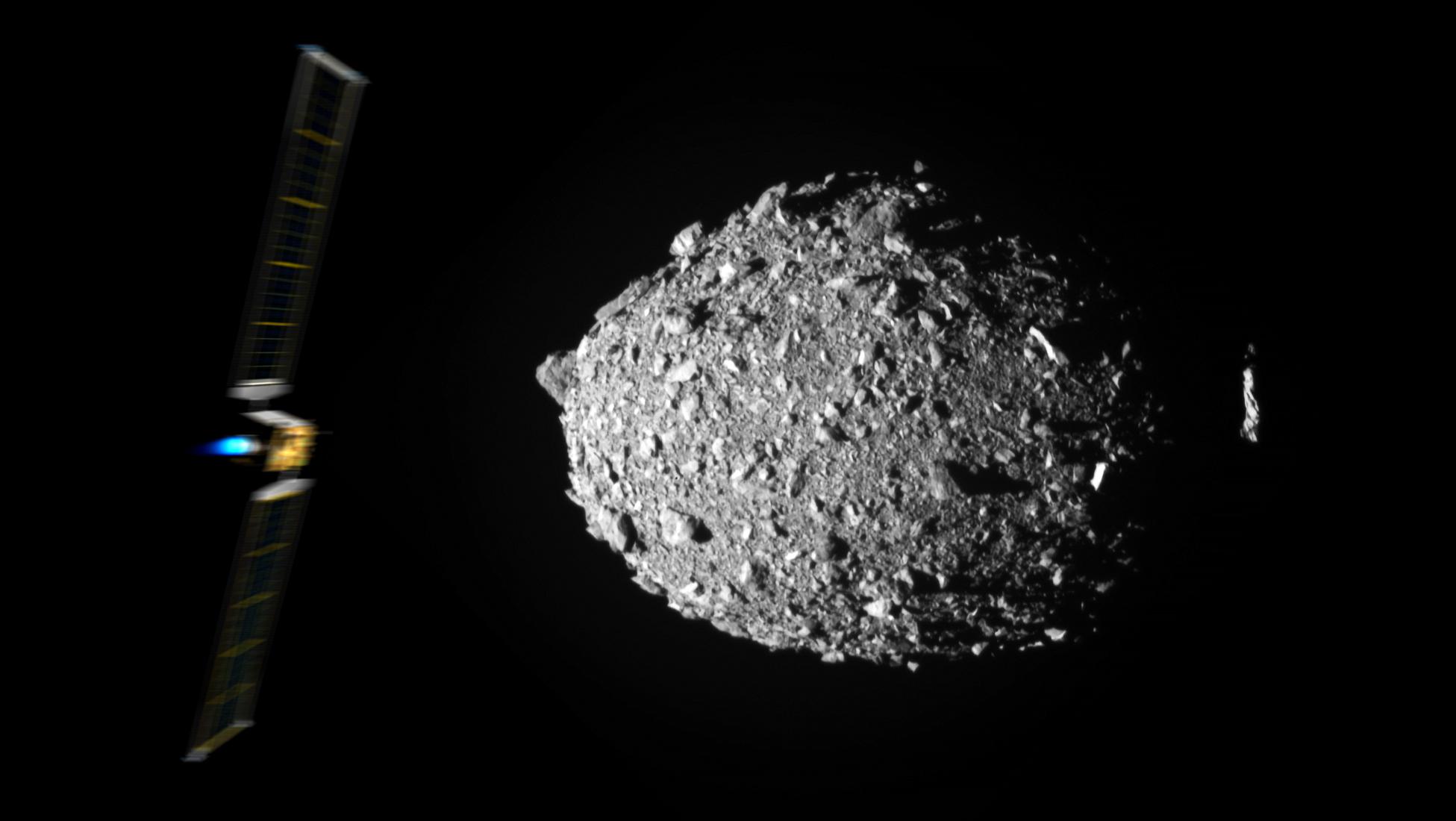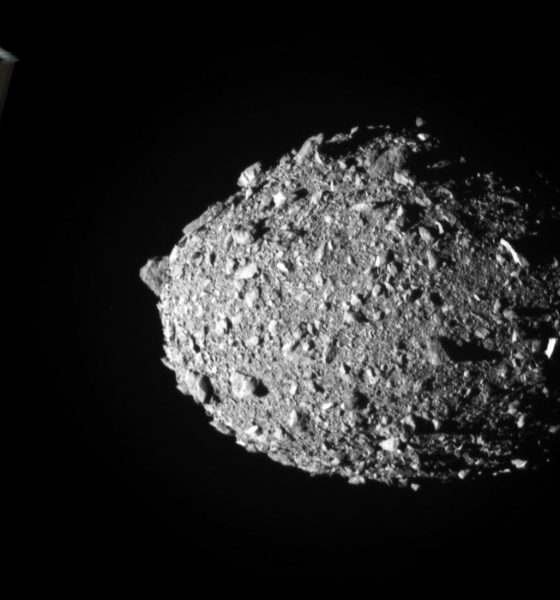

News
NASA spacecraft successfully slams into asteroid ten months after SpaceX launch
Ten months after launching into interplanetary space on a SpaceX Falcon 9 rocket, NASA’s Double Asteroid Redirect Test (DART) spacecraft has successfully impacted an asteroid moon.
Falcon 9 lifted off from Vandenberg Space Force Base (VSFB) Space Launch Complex 4 (SLC-4) carrying the 630-kilogram (~1400 lb) spacecraft on November 24th, 2021. The rocket performed flawlessly, continuing a streak of successful launches, and boosted DART on its way to a near-Earth asteroid pair.
The goal: slam into the small asteroid moon Dimorphos at an eyewatering speed of 6.3 kilometers per second (14,000 mph / Mach 18). Ten months later, the spacecraft has accomplished exactly that, successfully crashing into a target about 160 meters (530 ft) wide just 17 meters away from a perfect ‘bullseye’ after traveling for ten months and hundreds of millions of kilometers through space. Depending on the results NASA and dozens of other groups will now attempt to glean from ground and space telescopes, the successful impact could be a major leap forward for the field of planetary defense.
The main goal of planetary defense is to protect humanity’s home planet from asteroids, a threat that has routinely caused mass-extinction events throughout the multibillion-year history of life on Earth. With the technology to both detect and reach virtually all near-Earth objects (NEOs) more or less at hand, DART is the first attempt to test and verify what would seem to be the easiest and most obvious method of redirecting asteroids: knocking them off course with the spacecraft itself.
Planetary science and the behavior of things in microgravity conditions have a tendency to defy expectations, however, so testing that assumption is essential. The perfect way to do so came to DART Lead Investigator Andy Chang in a burst of mid-exercise inspiration: instead of hitting any odd NEO, a small spacecraft could slam into a tiny asteroid moon of a much larger parent asteroid. Hitting an asteroid moon would mitigate the small but nonzero risk of accidentally redirecting the target towards Earth while also amplifying the results, making them much easier to observe from tens of millions of kilometers away.
Rather than being forced to search for a virtually imperceptible change in a single asteroid’s half-billion-kilometer-long orbit, the results of hitting the right asteroid moon would be much more easily detectable as a change in the moon’s much smaller orbit around its untouched parent asteroid.
The problem is that aside from spectrographic readings that tell scientists the broad strokes of an asteroid’s composition and other telescope images that can make out the rough shape, it’s very difficult to scout the objects without actually visiting them. And given the difficulty, spacecraft have only visited a handful of the virtually countless asteroids of our solar system. Without knowing exactly what a target asteroid’s surface and subsurface are like, it’s hard to predict exactly what a spacecraft impacting that asteroid will do. A looser surface, which is what most visited asteroids appear to have, would be much worse at momentum transfer than a boulder or relatively solid surface of rock.
As an example, as DART rapidly approached and revealed more detailed views of the surface of Didymos and Dimorphos in its final minutes, Chang himself was surprised to see just how rough and boulder-strewn the surface of both asteroids were. Then, after the spacecraft impact, many scientists were also surprised to almost immediately see a massive cloud of dust – easily visible from ground-based telescopes – ejected from Dimorphos.
Despite the DART spacecraft’s eventful demise, the fun has only just begun on the ground as scientists attempt to solve that riddle (and many others) and begin searching for changes in Dimorphos’ orbit. Data will soon arrive from even larger and more prestigious observatories, including NASA’s space-based Hubble and Webb Space Telescopes. Italian companion cubesat LICIACube, which deployed from DART shortly before impact, will also downlink images it took up close, potentially offering the most detailed view of the impact for years.
Meanwhile, the European Space Agency (ESA) is developing a spacecraft called Hera that will launch in 2024 and attempt to enter orbit around Didymos and Dimorphos as early as late 2026 to examine the aftermath of DART’s last stand in even greater detail.
In the more distant future, particularly if the international science community ultimately concludes that DART did successfully redirect an asteroid (moon), it’s possible that the mission will help to kickstart an entirely new global project and fleet of spacecraft that will stand ready to protect Earth if the need ever truly arises. With a little luck and a modest amount of government funding, humanity may soon be able to entirely eradicate one of the most infamous sources of mass extinction.

News
Tesla aims to combat common Full Self-Driving problem with new patent
Tesla writes in the patent that its autonomous and semi-autonomous vehicles are heavily reliant on camera systems to navigate and interact with their environment.

Tesla is aiming to combat a common Full Self-Driving problem with a new patent.
One issue with Tesla’s vision-based approach is that sunlight glare can become a troublesome element of everyday travel. Full Self-Driving is certainly an amazing technology, but there are still things Tesla is aiming to figure out with its development.
Unfortunately, it is extremely difficult to get around this issue, and even humans need ways to combat it when they’re driving, as we commonly use sunglasses or sun visors to give us better visibility.
Cameras obviously do not have these ways to fight sunglare, but a new patent Tesla recently had published aims to fight this through a “glare shield.”
Tesla writes in the patent that its autonomous and semi-autonomous vehicles are heavily reliant on camera systems to navigate and interact with their environment.

The ability to see surroundings is crucial for accurate performance, and glare is one element of interference that has yet to be confronted.
Tesla described the patent, which will utilize “a textured surface composed of an array of micro-cones, or cone-shaped formations, which serve to scatter incident light in various directions, thereby reducing glare and improving camera vision.”

The patent was first spotted by Not a Tesla App.
The design of the micro-cones is the first element of the puzzle to fight the excess glare. The patent says they are “optimized in size, angle, and orientation to minimize Total Hemispherical Reflectance (THR) and reflection penalty, enhancing the camera’s ability to accurately interpret visual data.”
Additionally, there is an electromechanical system for dynamic orientation adjustment, which will allow the micro-cones to move based on the angle of external light sources.
This is not the only thing Tesla is mulling to resolve issues with sunlight glare, as it has also worked on two other ways to combat the problem. One thing the company has discussed is a direct photon count.
CEO Elon Musk said during the Q2 Earnings Call:
“We use an approach which is direct photon count. When you see a processed image, so the image that goes from the sort of photon counter — the silicon photon counter — that then goes through a digital signal processor or image signal processor, that’s normally what happens. And then the image that you see looks all washed out, because if you point the camera at the sun, the post-processing of the photon counting washes things out.”
Future Hardware iterations, like Hardware 5 and Hardware 6, could also integrate better solutions for the sunglare issue, such as neutral density filters or heated lenses, aiming to solve glare more effectively.
Elon Musk
Delaware Supreme Court reinstates Elon Musk’s 2018 Tesla CEO pay package
The unanimous decision criticized the prior total rescission as “improper and inequitable,” arguing that it left Musk uncompensated for six years of transformative leadership at Tesla.

The Delaware Supreme Court has overturned a lower court ruling, reinstating Elon Musk’s 2018 compensation package originally valued at $56 billion but now worth approximately $139 billion due to Tesla’s soaring stock price.
The unanimous decision criticized the prior total rescission as “improper and inequitable,” arguing that it left Musk uncompensated for six years of transformative leadership at Tesla. Musk quickly celebrated the outcome on X, stating that he felt “vindicated.” He also shared his gratitude to TSLA shareholders.
Delaware Supreme Court makes a decision
In a 49-page ruling Friday, the Delaware Supreme Court reversed Chancellor Kathaleen McCormick’s 2024 decision that voided the 2018 package over alleged board conflicts and inadequate shareholder disclosures. The high court acknowledged varying views on liability but agreed rescission was excessive, stating it “leaves Musk uncompensated for his time and efforts over a period of six years.”
The 2018 plan granted Musk options on about 304 million shares upon hitting aggressive milestones, all of which were achieved ahead of time. Shareholders overwhelmingly approved it initially in 2018 and ratified it once again in 2024 after the Delaware lower court struck it down. The case against Musk’s 2018 pay package was filed by plaintiff Richard Tornetta, who held just nine shares when the compensation plan was approved.
A hard-fought victory
As noted in a Reuters report, Tesla’s win avoids a potential $26 billion earnings hit from replacing the award at current prices. Tesla, now Texas-incorporated, had hedged with interim plans, including a November 2025 shareholder-approved package potentially worth $878 billion tied to Robotaxi and Optimus goals and other extremely aggressive operational milestones.
The saga surrounding Elon Musk’s 2018 pay package ultimately damaged Delaware’s corporate appeal, prompting a number of high-profile firms, such as Dropbox, Roblox, Trade Desk, and Coinbase, to follow Tesla’s exodus out of the state. What added more fuel to the issue was the fact that Tornetta’s legal team, following the lower court’s 2024 decision, demanded a fee request of more than $5.1 billion worth of TSLA stock, which was equal to an hourly rate of over $200,000.
Delaware Supreme Court Elon Musk 2018 Pay Package by Simon Alvarez
News
Tesla Cybercab tests are going on overdrive with production-ready units
Tesla is ramping its real-world tests of the Cybercab, with multiple sightings of the vehicle being reported across social media this week.

Tesla is ramping its real-world tests of the Cybercab, with multiple sightings of the autonomous two-seater being reported across social media this week. Based on videos of the vehicle that have been shared online, it appears that Cybercab tests are underway across multiple states.
Recent Cybercab sightings
Reports of Cybercab tests have ramped this week, with a vehicle that looked like a production-ready prototype being spotted at Apple’s Visitor Center in California. The vehicle in this sighting was interesting as it was equipped with a steering wheel. The vehicle also featured some changes to the design of its brake lights.
The Cybercab was also filmed testing at the Fremont factory’s test track, which also seemed to involve a vehicle that looked production-ready. This also seemed to be the case for a Cybercab that was spotted in Austin, Texas, which happened to be undergoing real-world tests. Overall, these sightings suggest that Cybercab testing is fully underway, and the vehicle is really moving towards production.
Production design all but finalized?
Recently, a near-production-ready Cybercab was showcased at Tesla’s Santana Row showroom in San Jose. The vehicle was equipped with frameless windows, dual windshield wipers, powered butterfly door struts, an extended front splitter, an updated lightbar, new wheel covers, and a license plate bracket. Interior updates include redesigned dash/door panels, refined seats with center cupholders, updated carpet, and what appeared to be improved legroom.
There seems to be a pretty good chance that the Cybercab’s design has been all but finalized, at least considering Elon Musk’s comments at the 2025 Annual Shareholder Meeting. During the event, Musk confirmed that the vehicle will enter production around April 2026, and its production targets will be quite ambitious.








